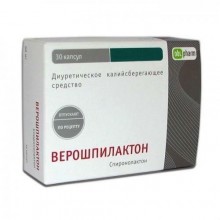



Spironolactone, an aldosterone antagonist, is competitively associated with aldosterone receptors in the distal renal tubule. Aldosterone acts as a potassium-sparing diuretic by increasing the amount of sodium and water excreted from the body while simultaneously delaying the excretion of potassium and magnesium. The diuretic effect usually develops on the 2-5th day of treatment and persists for 2-3 days after discontinuation of the drug.
1 tablet contains:
Active ingredient: spironolactone 100 mg.
Spironolactone is marketed under different brands and generic names, and comes in different dosage forms:
| Brand name | Manufacturer | Country | Dosage form |
|---|---|---|---|
| Verospilacton | Obolensky OP | Russia | capsules |
| Verospilacton | Obolensky OP | Russia | pills |
| Verospiron® | Gedeon Richter | Hungary | pills |
| Verospiron® | Gedeon Richter | Hungary | capsules |
No customer reviews for the moment.
pills are taken orally after meals.
Adults can take a daily dose in one or several doses.
Edema on the background of chronic heart failure:The initial dose is 25 mg / day, the maximum - 100 mg / day. Maintenance dose is determined individually.
Edema due to cirrhosis of the liver:100-400 mg / day (depending on the ratio of potassium and sodium). Maintenance dose is determined individually.
Peripheral edema on the background of nephrotic syndrome:the daily dose is 100-200 mg / day.
Essential hypertensionin adults: 50-100 mg / day. If necessary, the daily dose gradually over two weeks can be increased to 200 mg / day. The duration of treatment is at least 2 weeks.
Children: usually prescribed at the rate of 3 mg / kg body weight per day. The dose should be selected based on their response and tolerability of the drug. The multiplicity of reception is usually 1-2 times a day.
Diagnosis and treatment of primary hyperaldosteronism:can be used for initial diagnosis, as an indirect indicator of primary hyper aldosteronism in patients on a normal diet.Long test: adults - 400 mg / day for 3-4 weeks. The elimination of hypokalemia and arterial hypertension indirectly supports the diagnosis of primary hyper aldosteronism.Short test: The daily dose for adults is 400 mg for 4 days. If during the administration of spironolactone, the concentration of potassium ions in the blood serum increases, but decreases with the abolition of spironolactone, primary hyperaldosteronism should be considered as a possible diagnosis. After the diagnosis of hyper aldosteronism is made using more informative diagnostic tests, spironolactone can be taken in preparation for surgery at a dose of 100 to 400 mg / day.
In patients who are not subject to surgery, Verospilacton can be used as a long-term maintenance therapy in the lowest effective doses that are prescribed for the patient individually.
Prevention of hypokalemia with saluretic treatment:25-100 mg / day.
Missed dose: take the missed dose as soon as possible. Do not take it if there is no time left before taking the next dose. Do not take a double dose.
From the nervous system and sense organs: dizziness, drowsiness, lethargy, lethargy, headache, ataxia, confusion.
On the part of the digestive tract: nausea, vomiting, diarrhea, cramps, intestinal colic, gastritis, ulceration and bleeding in the gastrointestinal tract, abnormal liver function.
From the genitourinary system: gynecomastia (usually reversible, in rare cases may persist after discontinuation of drugs), pain in the mammary glands, erectile dysfunction in men, reduced potency in men, menstrual disorders or amenorrhea, menorrhagia during menopause, hirsutism, voice changes in women.
On the part of the skin: maculopapular or erythematous skin rashes, alopecia, hypertrichosis, pruritus, urticaria.
Other: calf muscle spasms, benign breast neoplasms, chest pain, leukopenia (including agranulocytosis), thrombocytopenia, electrolyte imbalance, hyperkalemia, increase in blood urea nitrogen, creatinine, osteomalacia, drug fever.
Hypersensitivity, Addison's disease, acute or rapidly progressive renal failure, chronic renal failure with a significant decrease in excretory function (Cl creatinine less than 10 ml / min), anuria, hyperkalemia, hyponatremia, hypercalcemia.
Carefully: Reduced renal excretory function, abnormal liver function (increased sensitivity to changes in electrolyte balance), diabetes mellitus (especially diabetic nephropathy), susceptibility to metabolic acidosis (with acidosis the hyperkalemic effect of spironolactone increases, spironolactone may contribute to the development of acidosis), menstrual disorders and / or breast enlargement, AV block (may be enhanced due to the development of hyperkalemia).
Pharmacodynamic interaction
Verospilacton reduces the sensitivity of vessels to norepinephrine.This should be taken into account when conducting general and local anesthesia in patients taking Verospilacton.
The simultaneous use of potassium-sparing diuretics with indomethacin or ACE inhibitors leads to the development of hyperkalemia. In combination with other diuretics and antihypertensive drugs Verospilacton enhances their action. Therefore, when adding Verospilacton to the treatment regimen, the dosage of such drugs should be reduced.
Pharmacokinetic interaction
Spironolactone has been shown to increase T1 / 2 digoxin. This can lead to an increase in the concentration of digoxin in the blood up to toxic, so when they are taken together it is necessary to reduce the dose or increase the interval between doses of digoxin.
Acetylsalicylic acid weakens the diuretic effect of spironolactone by blocking the secretion of the main metabolite - canrenone in the renal tubules. Indomethacin and mefanamic acid have been shown to inhibit canrenone excretion.
Spironolactone enhances the metabolism of antipyrine.
The use of spironolactone is contraindicated in the first trimester of pregnancy. In the II and III trimester of pregnancy is possible only under strict indications, if the expected effect of therapy outweighs the potential risk to the fetus.
Symptoms:nausea, vomiting, drowsiness, confusion, skin rash, diarrhea. Possible electrolyte imbalance and dehydration.
Treatment:Verospilactona should be stopped immediately, induce vomiting and flush the stomach. There is no specific antidote. Symptomatic treatment of dehydration, electrolyte imbalance and hypotension should be carried out. Elimination of hyperkalemia is achieved by the rapid administration of glucose (20-50% solutions) and insulin at the rate of 0.25-0.5 U of insulin per 1 g of glucose. Potassium-diuretics and ion exchange resins are used.
Studies and clinical trials of Spironolactone (Click to expand)